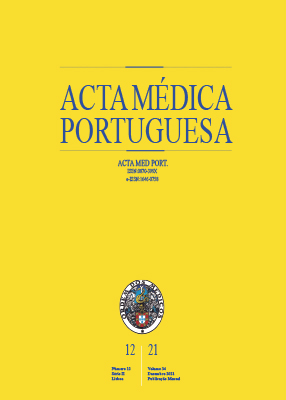Adult Native Joint Septic Arthritis: A Nine-Year Retrospective Analysis in a Portuguese University Hospital
DOI:
https://doi.org/10.20344/amp.12998Keywords:
Anti-Infective Agents, Antimicrobial Stewardship, Arthritis, Infectious, JointsAbstract
Introduction: Septic arthritis of a native joint represents a medical emergency. Drainage and effective antibiotic treatment are critical to avoid joint destruction and long-term impairment. The aim of this study was to evaluate epidemiological and clinical characteristics of patients with the diagnosis of septic arthritis to help establish local guidelines for empirical antibiotic treatment.
Material and Methods: Retrospective analysis of adult patients admitted at Centro Hospitalar Universitário do Porto from 2009 to 2017 with suspected native joint septic arthritis. Relevant demographics, microbiology findings and respective antibiotic susceptibilities were analysed.
Results: Ninety-seven patients, predominantly males (59.8%) with a median age of 61 years old were included. The most commonly reported comorbidity associated with septic arthritis was diabetes mellitus (20.6%). The knee was the most commonly affected joint (71.1%). Arthrocentesis was performed in all patients, but only 50.5% had positive microbial growth in the synovial fluid. Staphylococcus aureus was the most frequently identified microorganism, 86% of which were methicillin susceptible. Gram-negative bacteria were the causative agent in 15% of cases. A wide range of empirical antibiotic regimens were prescribed with a combination of vancomycin/carbapenem being the most common (30.9%). Analysis of antibiotic susceptibility profiles revealed that amoxicillin/clavulanate would have been appropriate as the initial regimen in 89% of cases.
Discussion: The main causative pathogen was Staphylococcus aureus, with methicillin resistant Staphylococcus aureus remaining rare. The proportion of Gram-negative bacteria implies that these agents should be covered by empirical treatment, although no case of Pseudomonas infection has been identified. Therefore, antipseudomonal coverage is not necessary in empirical regimens.
Conclusion: Routine coverage of methicillin-resistant Staphylococcus aureus and Pseudomonas aeruginosa is not warranted but must be considered when specific risk factors are found. Amoxicillin/clavulanate can provide adequate antibiotic coverage as an empirical treatment for adult native joint septic arthritis. Its use may allow a reduction in use of broader spectrum antibiotics.
Downloads
Downloads
Published
How to Cite
Issue
Section
License
Copyright (c) 2021 Acta Médica Portuguesa

This work is licensed under a Creative Commons Attribution-NonCommercial 4.0 International License.
All the articles published in the AMP are open access and comply with the requirements of funding agencies or academic institutions. The AMP is governed by the terms of the Creative Commons ‘Attribution – Non-Commercial Use - (CC-BY-NC)’ license, regarding the use by third parties.
It is the author’s responsibility to obtain approval for the reproduction of figures, tables, etc. from other publications.
Upon acceptance of an article for publication, the authors will be asked to complete the ICMJE “Copyright Liability and Copyright Sharing Statement “(http://www.actamedicaportuguesa.com/info/AMP-NormasPublicacao.pdf) and the “Declaration of Potential Conflicts of Interest” (http:// www.icmje.org/conflicts-of-interest). An e-mail will be sent to the corresponding author to acknowledge receipt of the manuscript.
After publication, the authors are authorised to make their articles available in repositories of their institutions of origin, as long as they always mention where they were published and according to the Creative Commons license.









